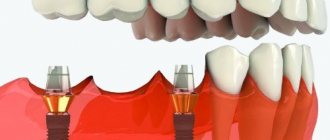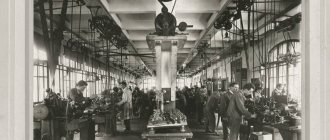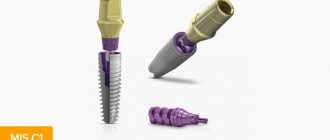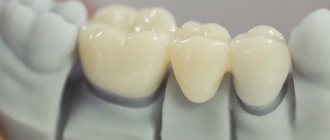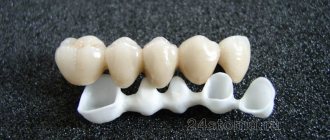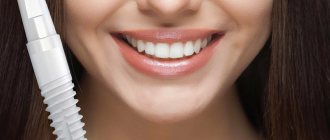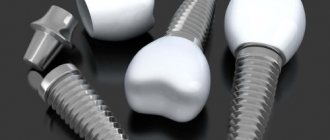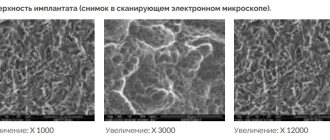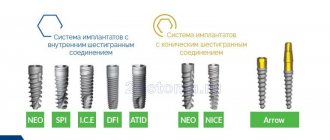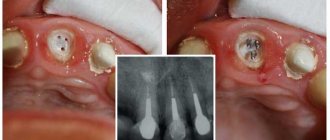With dental implantation, a lost tooth is replaced with an artificial analogue, which has a strong root and a visible part - a crown, which is as close in characteristics as possible to a natural tooth.
The crown should have a natural appearance and not stand out in the dentition, and also withstand the chewing load. Aesthetic requirements for the appearance of the crown increase significantly when implantation is carried out in the smile zone, therefore one of the most popular materials is zirconium dioxide.
PREMIUM DENTAL IMPLANTATION WITH ZIRCONIUM IMPLANTS BREDENT (GERMANY)
Zirconium implants are a modern development of European dental research centers in the field of safe dental implantation.
DENTAL CLINIC "BIONIC DENTIS" IS THE ONLY OFFICIAL CENTER FOR INSTALLING ZIRCONIUM IMPLANTS OF THE GERMAN MANUFACTURER BREDENT IN THE TERRITORY OF THE RF AND CIS COUNTRIES.
Our clinic, like many premium clinics in Europe and the USA, uses the method of installing zirconium implants.
We were the first in Russia to begin installing these structures and have accumulated extensive clinical experience, which helps us solve the most difficult problems that patients pose to us.
Zirconium implants No. 1 in the European I&O EU20 ranking
CLINICAL EXAMPLE OF ZIRCONIUM IMPLANT INSTALLATION
IN THE PHOTO: Clinical situation of edentulous lateral chewing tooth. The bone size was measured using the image.
IN THE PHOTO: Formation of the hole for the implant and the appearance of the zirconium implant
IN THE PHOTO: Installed implant and the situation after 2 weeks.
IN THE PHOTO: The crown on the implant and the x-ray show good quality and high aesthetics.
According to research by the European Osseointegration Association, 26 percent of patients have an allergic reaction to titanium, from which 98 percent of all dental implants used in the world are made.
Intolerance to titanium implants leads to the following consequences:
- implant rejection
- inflammation of bone tissue in the area of installed titanium implants
- inflammation of the gum tissue in the area of the installed implant
- discharge of pus from the gums
This clinical picture indicates rejection of the installed titanium implant and the need to remove it.
Special categories of patients have been identified who need to be especially careful when installing a titanium implant.
Patients in this category include:
- polyallergosis
- psoriasis
- hay fever
- allergy to metals
- multiple allergic reactions
These patients, before installing dental implants, must undergo laboratory tests - the Titanium Tolerance Test, which will show with 99 percent accuracy whether it is possible to safely install titanium implants or not.
If it is not possible to install titanium implants, then do not despair.
Modern dentistry includes zirconium implants in its range of methods. Such implants are the most technologically advanced of all systems on the market. They solve many of the problems with titanium implants that doctors and patients encounter.
Implant: why install?
Let us note right away that an implant and a denture are far from the same thing. The implant is only part of the prosthesis. It looks like an ordinary metal rod, which performs the main function of replacing the tooth root. It is implanted into the area of the lost tooth and is considered the basis for further prosthetics. In this case, one implant is installed for each lost tooth.
It is not always the case that a crown is placed on an installed implant, that is, a lost tooth is completely restored. Very often, a rod is implanted for further use as a support for removable dentures. In addition, implants are used if bridges cannot be made.
During prosthetics, a dismountable or non-separable implant can be used. Thus, a non-separable (otherwise called standard) implant is a metal rod presented in the form of a single integral structure. Standard implants make it possible to restore several incisors and molars at once. Such “pins” are most widespread.
A non-separable implant has several parts (in the standard form they are connected into a single whole): screw, crown, abutment, former, plug. In a collapsible design, all these parts are represented by separate elements.
In modern dentistry, noble metals are used to make implants: titanium and zirconium. While titanium structures have been used for many years, zirconium implants have come into the dental field recently.
ZIRCONIUM IMPLANTS STRUCTURE FEATURES
The shape of a dental implant, the type and type of thread on it is called implant architecture. These zirconium structures have several distinctive features
- implants are monolithic, which means that the implant and abutment, which usually come separately, are combined into one structure with these implants.
- the threads on the implants have sharp edges, which allows them to effectively “bite” into the bone tissue and firmly fix themselves in it immediately after installation.
- This implant has the possibility of customization, which means that the dentist can change the shape and length of the implant in the abutment area. This feature allows you to ideally adjust the implant to the individual conditions of the oral cavity of each patient.
- The neck of the implant has a special shape; it has a cushion to which the gum tissue fits tightly, preventing bacteria from penetrating the bone and causing peri-implantitis. Additionally, this feature allows you to avoid gum inflammation and recession.
IN THE PHOTO: Implantation process
IN THE PHOTO: Installed implants
Are there any differences in the installation process?
There are differences in the process, but they are important for the surgeon rather than for the patient. Another feature of zirconium implants is that they have an unusual thread that minimally injures the bone. The installation principle itself is the same as with classical implantation. The doctor can also choose one of the implantation methods - one-, two-stage, one-stage, All-on-4 or All-on-6.
| Due to the fact that the models have a monolithic structure, the patient then does not need to install a gum former. The gum tissue heals well and adheres tightly to the implant. This reduces treatment time by 2–4 weeks. |
ZIRCONIUM IMPLANTS INDICATIONS FOR INSTALLATION
The main indications for installation of zirconium implants are as follows:
- missing one tooth in the anterior jaw
- missing several teeth in the anterior jaw
- missing one tooth in the lateral jaw
- missing several teeth in the lateral jaw
- a “loose” tooth, in this situation the tooth is removed, and a zirconium implant is immediately installed in the hole in the bone where it was located.
- tooth fracture; in this situation, the implant is inserted into the bone in place of the unusable tooth immediately after its removal.
- a crack in the root of the tooth, in which case the cracked root is replaced with an implant.
- allergic reaction to titanium implants
- intolerance, lack of tolerance to titanium
- the need to install implants in patients with psoriasis
- the need to install implants for people with polyallergosis.
In Russia, doctors and patients have a misunderstanding about the indications for installing zirconium implants; such implants are recommended only for “problem” patients with an allergy to titanium or after the patient experiences rejection of previously installed titanium implants.
However, European dental practice shows otherwise: zirconium implants are the method of choice for any clinical situations requiring dental implantation.
Zirconium implants are most often used in Europe and the USA in premium dental clinics, as they are the most well-proven implants and bring stable clinical results.
Postoperative period
During this period, the patient must be prescribed antibiotics and painkillers. In addition, the doctor talks about the following mandatory visits, which are usually prescribed for the first, third and seventh month. You should definitely visit a doctor if you feel unwell or have other alarming symptoms. During your visit, your doctor may order a repeat x-ray.
During this period and beyond, it is necessary to carefully care for your teeth. Be sure to use paste and a brush. In this case, the brush must be made of a material that cannot damage the surface of the dentures. Ceramic and metal-ceramic dental prostheses are considered lightweight and easy to care for. They are not afraid of abrasive substances and are easy to clean.
After installation, complaints of increased tooth sensitivity and unpleasant discomfort are often heard. These phenomena can be eliminated. To do this, solid foods are removed from the diet for a short time (especially in the first weeks). Wearing night braces is recommended for patients with bruxism. These devices are generally manufactured individually for each patient. Be sure to visit the dentist's office for an examination once every six months. The doctor’s final recommendations must be followed.
ZIRCONIUM IMPLANTS, ADVANTAGES OF USE
In clinical practice in dental implantation, doctors encounter some problems that sometimes do not allow them to achieve high results in the rehabilitation of patients with partial and complete loss of teeth.
European research centers have been constantly working to improve the materials and structure of dental implants.
One of the most important achievements in modern medicine is the creation of zirconium implants.
Problems faced by implantologists and their patients solved thanks to the use of zirconium implants:
- An allergic reaction to titanium was found in 26 percent of patients. It is clinically proven and diagnosed using the Titanium Tolerance Test. Previously, such patients were denied implantation, but with the use of medical zirconium for the manufacture of implants, this problem was completely solved. An allergic reaction to zirconium has not yet been recorded in more than one patient.
- contamination of the internal space of the implant. Inside the implant there is a small recess in which a thread is cut. Due to this thread, an abutment is attached to the implant. However, multiple studies have shown that the internal cavity in the implant is always infected and is an excellent space for the reproduction and growth of pathogenic bacteria, which lead to implant rejection. Zirconium implants are monolithic, that is, the implant and abutment are manufactured from one block of zirconium. Thanks to this manufacturing method, there is no cavity in the implant, which means there is no colony of bacteria and no possibility of inflammation.
- poor stability of the implant-abutment connection. In titanium implants, the abutment and implant are 2 separate structures that are connected by a screw. When chewing movements in the oral cavity, the screw is constantly under stress or overload. Over time, the screw weakens the fixation of the abutment to the implant and the connection becomes loose. As a result, the crown falls off the implant. A frequent complication in prosthetics on implants is a fracture of the fixation pin; under high load, the screw fixing the abutment to the implant breaks into 2 parts. The lower part jams in the implant, blocking the thread. In 85 percent of cases, such a screw fragment cannot be removed and the implant has to be removed and a new one installed. This results in financial costs and stress for the patient. Due to the fact that the zirconium implant is a monolithic implant/abutment structure, it has a reinforcement zone in the place where it experiences overload. The monolithic structure is 800 percent stronger than screw-fastened parts, providing unsurpassed strength and durability.
- violation of the aesthetics of soft tissues due to the transillumination of a dark implant. This implant is dark gray in color. In cases where the patient has thin gum tissue, such an implant will be visible through it and will affect the aesthetics. The zirconium implant is white, it is not translucent and looks perfect in the oral cavity.
- the problem of gum recession and implant exposure. Over time, the bone tissue of a titanium or zirconium implant begins to settle. However, the implant is firmly anchored in the bone. In the case of a titanium implant, if such a problem occurs, the implant should be removed and replaced with a new one. In the case of a zirconium implant, this problem is simply solved without removing the implant. It is enough to grind off the threads on the protruding part of the implant and polish it. After which only a new crown is installed, and the implant continues to serve for many, many years.
- the problem of penetration of microbes due to the lack of connection between the gum and the neck of the implant. An important feature of your own tooth is that the gum tissue adheres to its neck, preventing the penetration of mircobs from the oral cavity directly to the jaw bone. When a tooth is lost and a titanium implant is installed, tissue tissue cannot stick to the metal neck of the implant, and microbes pass under the gum without hindrance. In the case of zirconium implants, the connection between the gum and the zirconium neck is much tighter. Of course, it is inferior in strength to the connection between the gum and the neck of a natural tooth, but it is many times superior to such a connection between the gum and metal. Thanks to the use of zirconium in implantation, the patient’s gums look healthy and indistinguishable from the gums of their own teeth.
BIO CONCEPT OF IMPLANTATION IS A WORLD TREND
Biological dental implantation is an internationally recognized trend:
- We do not injure the patient’s own tissues
- We do not introduce foreign metal implants
- We follow natural principles of prosthetics and implantation
Are zirconium implants different from titanium implants?
- Classic titanium structures. They consist of the implants themselves, which are installed in the jawbone, and abutment attachments - with their help, a crown, bridge or complete denture is fixed to the implants.
- Zirconium structures. Monolithic, in which the artificial tooth root is integral with the abutment. Therefore, the connecting screw does not break or loosen in them - it simply does not exist.
Their upper part can be ground down like an abutment tooth before fixing a crown on it. This allows the doctor to ideally secure the orthopedic structure in the desired position, and the patient to receive comfortable and good dentures.
| Not only we, but also our colleagues in many clinics note that zirconium models take root faster. This is especially true for patients with insufficient or poor bone quality. In some cases, it is even possible to do without bone grafting, which saves the patient money and six months of time. |
ZIRCONIUM IMPLANTS CONTRAINDICATIONS FOR USE
There are few contraindications for the use of zirconium implants:
- oncological diseases of the jaw bone
- use of pure bisphosphonate drugs
- diabetes mellitus in an uncompensated state with a sugar level above 10.
- Stage III osteoporosis.
- osteomyelitis of the jaw
- periostitis of the jaw
- mental illness
IN THE PHOTO: Correspondence between the shape of the root of your own tooth and the shape of the zirconium implant.
Pros of zirconium implants
Zirconium options have a lot of advantages and advantages, among their diversity the following can be distinguished:
- when using them, the risk of various complications is practically reduced to zero;
- invisibility to others;
- there is no need to wait a long time for the opportunity to put stress on the teeth after implantation;
- no allergies;
- long-term preservation of its properties and qualities;
- possibility of installation even with periodontal disease;
- high strength indicators;
- the implant does not shrink even after long-term use;
- the likelihood of caries and other troubles is reduced to zero;
- there is no need to grind the teeth before installation;
- low level of thermal conductivity;
- Duration of operation - at least 15 years.
INSTALLATION OF A ZIRCONIUM IMPLANT IN A PATIENT WITH AN ALLERGY TO TITANIUM
We bring to your attention a complex clinical case of rehabilitation of a patient using zirconium prostheses.
Patient Tatyana Dmitrievna contacted the Bionic Dentis dental clinic with the need to install dental implants in place of lost teeth.
A concomitant problem of the patient was an allergy to metal.
We conducted a Titanium Tolerance Test, which showed a high level of allergic reaction to titanium implants and the impossibility of using metal implants.
It was decided to install a BREDENT zirconium implant.
The patient underwent implantation surgery and installation of a zirconium dioxide crown.
An excellent result was obtained.
There is no implant rejection.
Clinical effect 10 out of 10;
What are zirconium prostheses?
- For the smile area , where aesthetics are especially important, crowns with ceramic coating are used. Artificial teeth look as natural as possible;
- For chewing teeth , when strength is important, crowns made of solid zirconium, tinted to match the shade of the dentition, are used.
The Esthetic Classic Dent clinic provides the following types of prosthetics:
- a single zirconium crown
- for the loss of one tooth; - with crowns that are part of a bridge prosthesis (“bridge”) - if necessary, restore 2 - 4 consecutive teeth;
- crowns installed in a complete denture - when the entire dentition of the jaw is subject to restoration.
MANUFACTURERS OF ZIRCONIUM IMPLANTS
The global dental market is quite extensive. Several well-known implant manufacturers have begun making them from zirconium.
Currently, the following types of zirconium implants are known in the world:
- Nobel Bioker
- Straumann
- Bredent.
The German company BREDENT is a leader in the development of innovative products in dentistry. High German quality and modern developments in dentistry make this implant unsurpassed among its analogues.
The only zirconium implants approved for use in the Russian Federation are BREDENT implants. They successfully passed clinical trials and received a registration certificate from Roszdravnadzor.
While obtaining permission for use in Russia, BREDENT implants underwent the most stringent toxicological and clinical tests, which showed that these implants are ideal for eliminating dental defects in any clinical cases.
What is zirconium dioxide
This material revolutionized dental orthopedics in the mid-1990s due to its unique combination of strength and aesthetics. The mechanical properties of zirconium dioxide are similar to those of certain types of steel. Therefore, even crowns with thin walls are highly durable. This allows for minimal grinding of the supporting tooth tissue.
This is a white material that can be colored according to the VITA scale, precisely selecting the shade for a particular patient. Due to this, zirconium crowns visually merge with their “neighbors” along the dentition. They do not have an opaque frame, there is no dark border at the bottom, like metal ceramics.
HOW TO PLACE ZIRCONIUM IMPLANTS
Zirconium implants require special installation techniques. Unfortunately, in Moscow, only 2-3 clinics have the conditions for installing zirconium implants. The qualifications of the implant surgeon who performs the operation are also important.
Let us consider the features of installing zirconium implants in patients with partial loss of teeth.
- Before implantation, the patient is prescribed laboratory blood tests, which include: a clinical blood test, a biochemical blood test, and the determination of certain infections. This is necessary so that the doctor sees that the state of health allows the operation to be performed and implant rejection will not occur.
- To plan implantation and accurately select the size of the implant, the patient undergoes a computed tomography scan. Tomography examines the density of bone tissue, determines the optimal position of the implant in relation to neighboring teeth, blood vessels, nerves, and sinuses of the jaw.
- A special feature of installing a zirconium implant is that the implant must be ideally installed correctly, its inclination must be taken into account, and its position inside the crown must be taken into account. Such precision installation cannot be done by eye. Navigation systems are used for correct positioning. The implantologist uses a computed tomography scan using modern computer programs to select the ideal place to insert the implant into the bone. At the same time, he sees in the program how the implant will relate to any of the crowns he has chosen. After determining the implantation site, a navigational implant template is made on a No. D printer. This template is used during surgery to make a hole for the implant in the correct place. Thanks to this method, implantation does not take much time, and the implantologist and patient receive the ideal position of the implant and the highest quality prosthetics.
- A hole is prepared in the bone into which the implant will be screwed. The hole is made using calibrated cutters, with constant cooling with sterile saline solution. This technique eliminates overheating of the bone and the appearance of unpleasant sensations during surgery and bone burns. The implant is screwed into the bone using a computerized system that calculates the stress in the bone during implant placement and prevents compression of the bone tissue, which can negatively affect the results of the implantation.
- After installing the implant, a pair of sutures are placed on the gum to ensure its adherence to the neck of the implant.
- An important feature of BREDENT zirconium implants is that the doctor has the ability to adjust its height. All patients are different, and the height of the teeth is different for everyone; it cannot be calculated in advance. Therefore, the dentist, after installing the BREDENT zirconium implant, can shorten it so that its height ideally matches the height of the patient’s neighboring teeth.
Indeed, installing a zirconium implant is not an easy task for a specialist, but the quality that is achieved with its use is many times greater than the complexity of its installation.
Benefits of zirconium dioxide, in what cases is it used?
- Requires minor grinding (1 mm), which helps preserve the pulp. The tooth remains alive and does not decay further.
- Does not cause a reaction upon contact with saliva. The gums will not become inflamed or turn blue.
- Compatible with living tissues. Rejection does not occur, soft tissues do not change color.
- Originally white. Even if the gums sag, a cosmetic defect will not occur.
- Lasting. The risk of chipping is minimal. If this happens, just polish the surface.
- Has variable density. It increases from the cutting edge to the base. Therefore, the opposite tooth does not suffer.
WHAT CROWNS ARE PUT ON ZIRCONIUM IMPLANTS
A zirconium implant is a monolithic structure that is embedded into bone tissue. After implantation, it is necessary to make a crown, which will be fixed to the implant and with its help the process of chewing food occurs.
For prosthetics on zirconium implants, BREDENT offers 2 crown designs:
- Zirconium crowns. These crowns are very durable and can be installed on the front and back teeth. These crowns are indistinguishable from your own teeth and are perceived by others as your own teeth. They are easy to use and last up to 20 years. The main advantage of zirconium crowns on zirconium implants is that when replacing several missing teeth, fewer implants can be installed, and the crowns can be made in the form of bridges. This does not reduce the quality of work and prosthetics, but significantly reduces the cost of implantation and prosthetics by reducing the number of implants installed.
- Lithium disilicate crowns. This is the most modern material in dentistry and in Germany it is often called artificial tooth enamel. Such crowns can be installed in the anterior and lateral parts of the jaw during prosthetics on zirconium implants. These crowns belong to the premium segment in dental prosthetics. They exactly replicate natural teeth, and even a professional dentist cannot always distinguish whether it is a lithium disilicate crown or the patient’s own natural tooth. This crown has one drawback. Bridges cannot be made from lithium disilicate. Therefore, if a patient needs to reduce the cost of dental prosthetics on implants, then such a crown is not recommended for him. The basic principle of using lithium disilicate crowns in implantology is one implant - one crown.
Zirconium dioxide crowns: methods of attachment to an implant
Today there are 2 ways of attaching crowns to an abutment - screw and cement. Each of them has its own advantages and disadvantages.
With screw fastening, the doctor makes a hole in the crown and connects the parts of the structure with a screw. This occurs outside the patient's mouth. The hole is then closed with filling material. The advantage of this type of structure is the ability to disassemble it and replace the crown if necessary. The disadvantage is the rigidity of the structure.
With the cement method, the crown is attached to the implant, as with a conventional crown installation, using special cement. This method allows for greater maneuverability with the angle of the crown, which allows for greater anatomical compatibility and a natural position of the new tooth in the patient’s mouth. Disadvantages - the structure is not removable. If excess cement gets under the gum, an inflammatory process can begin.
HOW PROSTHETICS ARE CARRIED OUT WITH ZIRCONIUM IMPLANTS
Prosthetics with BREDENT zirconium implants require high precision and care from the dentist. How this technique was developed in Germany and the Germans demand very strict fulfillment of the requirements.
After installation, a plastic impression cap is placed on the implant.
This device allows you to make a very clear impression and accurately produce a working model.
There are 2 principles of prosthetics on BREDENT zirconium implants
- Analog prosthetics. With this technique, the dentist takes impressions of the teeth, and the dental technician makes a plaster model on which the crown is made.
- Digital prosthetics. This technique assumes that the prosthetist will scan the oral cavity and the installed implant using a special No. D camera. As a result of scanning, a virtual model is obtained in a computer program, on the basis of which the crown is modeled. The crown is made by cutting it out of a zirconium blank using a special robot - a milling cutter. Such crowns have very high precision and last longer.
Turnkey crown installation at ActiveStom
After making an appointment, you will be examined by a dentist who will determine the indications for prosthetics, draw up a treatment plan and tell you what the turnkey price consists of in your clinical case.
Further actions by doctors may include treatment of deep caries and filling of root canals. It may be necessary to remove a tooth if it is objectively beyond restoration. We will work with you to select affordable implants.
When the supporting tooth is processed or the implant has taken root, our doctor takes an impression of the dentition. Based on it, a crown will be made in the laboratory: the impression is scanned, and a 3D model of the future prosthesis is created on a computer. Based on this model, the milling module cuts out the finished crown from a zirconium blank. Then it is finished by hand, giving it an absolute resemblance to a real tooth. When the prosthesis is ready, you will be invited to install it.
ZIRCONIUM IMPLANTS COST
Features of manufacturing and installation of zirconium implants determine their higher cost.
The cost of zirconium implants in Moscow ranges from 110,000 to 160,000 rubles per unit.
Our clinic, thanks to direct cooperation with the implant manufacturer BREDENT, offers its patients the best prices for using this system.
PRICES FOR ZIRCONIUM IMPLANTS IN 2022
Prices for zirconium implants in 2022 highly depend on:
- level of the clinic you contacted.
- the level of professionalism of the implantologist who will perform implantation.
- the crown material from which it will be made.
- the need for bone grafting and bone augmentation, sinus lifting.
- the need for plastic surgery or gum grafting.
- the need and difficulty of removing a broken or cracked tooth and replacing it with an implant.
Prices for zirconium implants are slightly higher than for titanium ones. However, this is a qualitatively different level of dentistry, which has a high cost and requires maximum professionalism from the doctor.
REVIEWS OF PATIENTS WHO HAVE INSTALLED ZIRCONIUM IMPLANTS
Patient reviews of zirconium implants are only positive. Over 5 years of practice, we have not received more than one negative review from patients about this design.
According to the results of research on the Internet and collection of statistics, in their reviews of zirconium implants, patients note:
- no discomfort during implantation surgery.
- no pain at the implantation site
- absence of gum inflammation and rapid healing
- absence of darkening of the gums and absence of dark translucency of the implant through the gums.
- Convenience when brushing teeth and cleaning the implantation area.
- high aesthetic result.
- invisibility and naturalness of the implant.
WHERE TO PUT ZIRCONIUM IMPLANTS
Zirconium implants can be installed in clinics in the USA, Europe and several dental clinics in the Russian Federation.
In Moscow, the Bionic Dentis dental clinic specializes in the installation of BREDENT zirconium implants.
Since 2007, the clinic has performed more than 1,000 installations of zirconium implants.
Our clinical experience in this area significantly exceeds that of any other clinic in Russia.
We provide our patients with a lifetime guarantee on implants.
When choosing a clinic to install zirconium implants, you need to pay attention to the following points:
- How long has this technique been practiced in the clinic?
- What experience does the clinic's implantologist have in working with zirconium implants?
- Is the implantologist certified, is he a member of the Russian Association of Implantologists?
- What is the warranty period for the implant?
- Does the clinic use the implantology navigation system No. D for implant installation?
- Does the clinic provide a certificate of conformity and a registration certificate from Roszdravnadzor for installed implants?
- Is the clinic an authorized partner or representative office of BREDENT?
"Bionic Dentis" is the ONLY authorized BREDENT dental implantation center in the Russian Federation and the CIS.
We have the most clinical experience.
We install zirconium implants at the best price.
Each patient is given a package of documents that confirms the authenticity of the implant and the legality of its import into the Russian Federation.
IMPLANTOLOGISTS WHO INSTALL ZIRCONIUM IMPLANTS
The complexity of installing BREDENT zirconium implants is compensated by their long service life. However, this complexity does not in any way concern our patients.
The clinic’s implantologist surgeon, Dr. Petr Vladimirovich Ozerov, has 17 years of clinical experience, is a member of the Russian Dental Association and is certified by BREDENT to install zirconium implants.
The professionalism of our implantologist is recognized by a professional society.
Our clinic hosts educational courses in which Petr Vladimirovich, in lecture and practical parts, trains implantologists from the Russian Federation and the CIS in techniques for installing zirconium implants.
By choosing our clinic, you get a leading specialist in the Russian Federation, high-quality implants and the best level of service in the Russian Federation.
The implantologist has been a full member of the Russian Association of Dental Implantology since 2012.
